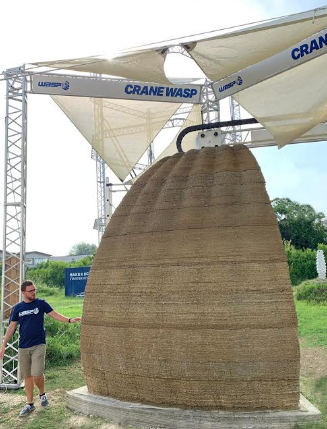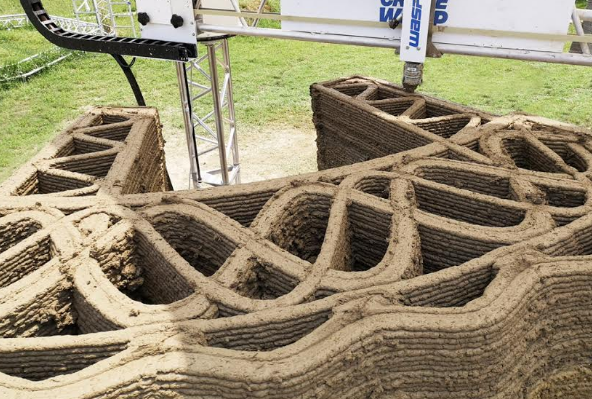


WTEC 3D打印机已成为社区生活的代名词,因为TECLA理念紧随意大利Shamballa的多年工作而来。 WASP和Mario Cucinella Architects(MC A)是意大利3D打印领域的开创性专家,他们合作在博洛尼亚安装了3D打印栖息地。
The WASP 3D printer is becoming synonymous with community living, as the TECLA concept arrives on the heels of years of work on the Shamballa village in Italy. Known as pioneering specialists in 3D printing for Italy, WASP and Mario Cucinella Architects (MC A), collaborated on the 3D printed habitat being installed in Bologna.
受人口过剩问题的启发,采用Crane WASP 3D打印的圆形房屋模型旨在为所有人提供负担得起的房屋。TECLA由当地地形中使用的可完全回收的材料制成,其造型仿效了全球生态住房的发展。
Inspired by issues with overpopulation, the circular housing model to be 3D printed with the Crane WASP is meant to offer affordable housing to everyone. Created with completely recyclable materials used from local terrain, TECLA (modeled after offers another foot forward in eco-housing around the globe.
“ 我们以可持续的视角建造3D打印房屋。最古老的材料和最先进的技术融合在一起,给世界带来新的希望,这是我们一年前用生土制成的首个3D打印房屋。今天,我们与合作伙伴一起在TECLA上打印整个生态可持续的栖息地。这个星球正在要求我们与马里奥·库奇内拉(Mario Cucinella)共享一个联合项目。”盖亚·马西莫·莫雷蒂(Massimo Moretti)说。
“WASP takes inspiration from the potter wasp. We build 3D printed houses using earth found on the spot, under a sustainable perspective. The oldest material and a state of the art technology merge to give new hope to the world, our first 3D printed house made with raw earth, was born a year ago. Today with our partners we are printing TECLA an entire eco-sustainable habitat. The planet is asking for a joint project that we share with Mario Cucinella,” says Massimo Moretti – Gaia.

TECLA应成为历史,成为与众多3D打印机一起开发的首个房屋领域,它使用的是可生物降解和可回收的“ km 0天然”本地粘土,旨在最终创建零废物建筑。TECLA旨在适应多种环境,将通过选择环境和自我生产来定制TECLA。
TECLA should make history as the first area of homes developed with numerous 3D printers working together, using locally sourced clay that is both biodegradable and recyclable ‘km 0 natural,’ meant to ultimately create a zero-waste building. Meant to adapt to more than just one environment, TECLA will be customized via choices for environment and self-production.
“ TECLA是利用可持续发展进行深入研究而成的,该学院是由Mario Cucinella创建的专业学校,集教育、研究和实践于一体。这项研究是在伦敦建筑协会建筑学院的可持续环境设计硕士学生的支持下进行的,探讨了无家可归的原因和影响。根据在不同气候条件下的案例研究,它询问了使用技术进步来实现解决方案的问题。WASP团队说:“这是一个高度灵活的封套,旨在适应任何气候和能源变化。”
“TECLA was developed using in-depth research undertaken by the School of Sustainability – a professional school founded by Mario Cucinella that combines education, research and practice. The research, conducted with the support of MA students from the Sustainable Environmental Design program at the Architectural Association School of Architecture in London, explored the cause and effects of homelessness. It interrogated the use of technological advances to enable a solution, based on case studies in locations with different climates. The result is a highly flexible envelope, designed to be resilient to any climate and energy-efficient in a way that traditional housing models are not,” said the WASP team.
他们与MC A的合作得到了支持,这意味着他们可以学习材料和主要成分。RiceHouse创建了结构测试,研究团队经常需要为客户零件提供帮助。TECLA代表该城市关于尊重环境的协议。
Their collaboration with MC A has been supported, which is good, meaning they can study materials and main components, much of which is so optimized it must come from the raw earth. RiceHouse created structural tests, and the research teams often needed help to customer parts. TECLA, or an imaginary city represents the city’s agreement regarding the need for environmental respect.
“ TECLA于2019年5月获得计划批准,于2019年9月开始印刷,并将于2020年初完成。从位于Massa Lombarda的WASP总部的第一台原型机开始,该项目的目的是致力于在全球各地建立智能住宅社区。
“TECLA received planning approval in May 2019, commenced printing in September 2019, and is due to complete by the beginning of 2020. Starting with the first prototype at WASP headquarters in Massa Lombarda, the project’s aim is to work towards communities of smart houses around the world,” said the research group.

研究人员说:“ WASP和MC A的合作得到了全球建筑材料生产商Mapei的支持,该公司对粘土材料进行了研究,并确定了原土混合物中的关键成分,从而创造出最终高度优化的可印刷产品。” “结构测试是由米兰工程咨询公司Milan Ingegneria进行的,该公司致力于优化形状以创建自支撑结构”
“The collaboration between WASP and MC A has been supported by Mapei, a worldwide producer of construction materials, which has studied the clay materials and identified the key components within the raw earth mixture to create the final highly optimized printable product,” stated the researchers. “Structural tests were carried out by Milan Ingegneria, a Milan-based engineering consultancy, which worked on the optimisation of the shape in order to create a self-supporting structure. Frames created by Capoferri and Frassinago.”